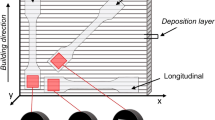Abstract
The relatively complex microstructures developed at the interface between ferritic steel and weld metal on austenitic-ferritic transition joints have been examined by metallographic observation and by hardness tests in the as-welded condition and in the as-welded-and-tempered condition. Both austenitic stainless steel and nickel-based filler metals were used in welds. On as-welded specimens a sharp change of hardness in low-alloy steel has been measured, with increasing distance from weld metal; the hardness values have been related to the observed metallographic constituents. On post-weld heat treated specimens, the behaviour is different according to the composition of filler material, either austenitic steel or nickel-based alloy. In the case of austenitic filler material, a dark-etching narrow diffusion region of carbon toward weld metal is formed, with an adjacent markedly decarburized zone, exhibiting the minimum microhardness values in a narrow band of about 60 micrometres. Since this sharp structural variation is recorded just in the zone where often failures occur, the final post-weld heat treatment appears to be proposed with due caution. In the case of nickel-based filler material, carbon diffusion is inhibited by the precipitation of alloy carbides at the weld interface. This determines a more homogeneous heat affected zone (HAZ) in the ferritic steel and a reduced decarburization near the fusion line after a post-weld heat treatment, confirming the reasons of the preference recognized to this filler material, especially when service temperature is elevated and submitted to frequent changes, or whenever a post-welded heat treatment is required.
Similar content being viewed by others
References
R. L. Klueh andJ. F. King,Weld. J. 61 (9) (1982) 302-s.
K. F. Hale, “Physical metallurgy of reactor fuel elements” (The Metals Society, London, 1975) pp. 193–201.
A. K. Hardy, T. Rowley andJ. A. Williams, “Ferritic steels for fast breeder reactor steam generators” (British Nuclear Energy Society, London, 1978) p. 36.
R. L. Klueh, J. F. King andJ. L. Griffith,Weld. J. 62 (6) (1983) 154-s.
I. J. Chilton, A. T. Price andB. Wilshire,Met. Technol. 11 (9) (1984) 383.
M. D. C. Moles, M. J. Tinkler andH. J. Westwood,ibid. 8 (4) (1981) 121.
J. F. King, M. D. Sullivan andG. M. Slaughter,Weld. J. 56 (11) (1977) 345-s.
R. D. Nicholson,Met. Technol. 9 (8) (1982) 305.
R. W. E. Emerson, R. W. Jackson andC. A. Dauber,Weld. J. 41 (9) (1962) 385-s.
A. Schrader, A. Rose, “De Ferri Metallographia” (Verlag Stahleisen GMBH Dusseldorf, 1966) p. 127.
Author information
Authors and Affiliations
Rights and permissions
About this article
Cite this article
Gauzzi, F., Missori, S. Microstructural transformations in austenitic-ferritic transition joints. J Mater Sci 23, 782–789 (1988). https://doi.org/10.1007/BF01153967
Received:
Accepted:
Issue Date:
DOI: https://doi.org/10.1007/BF01153967




